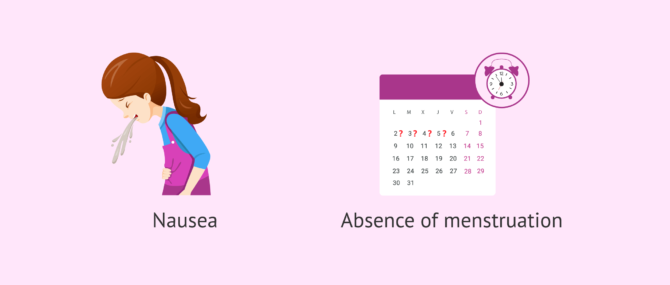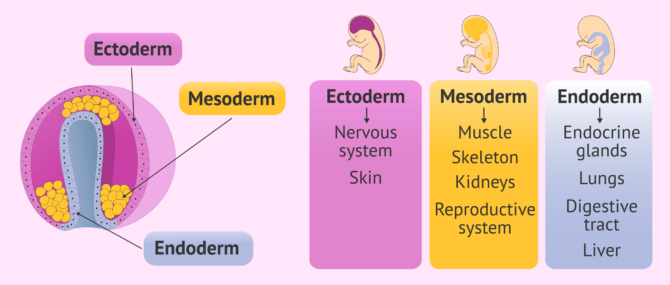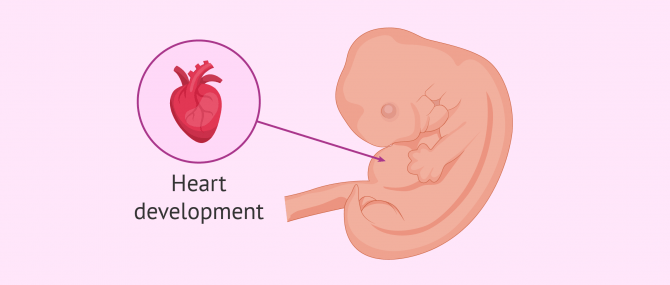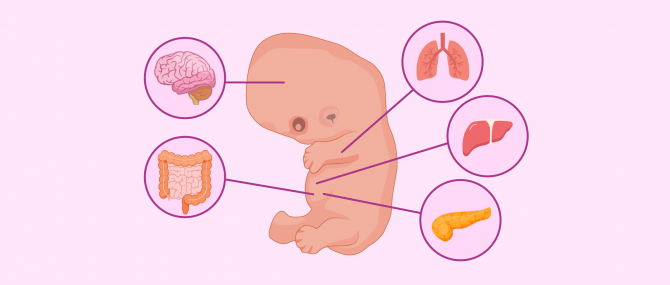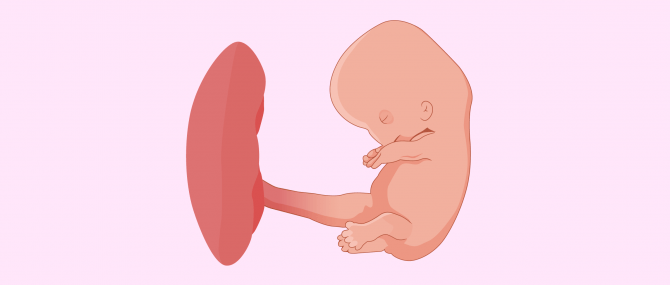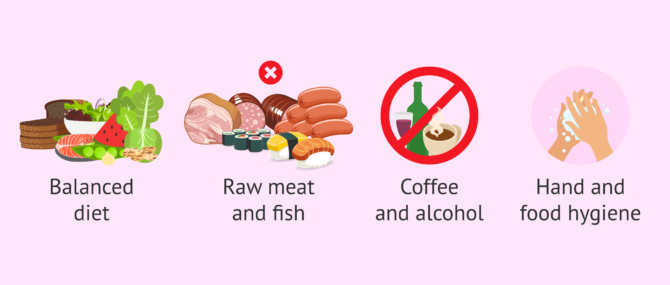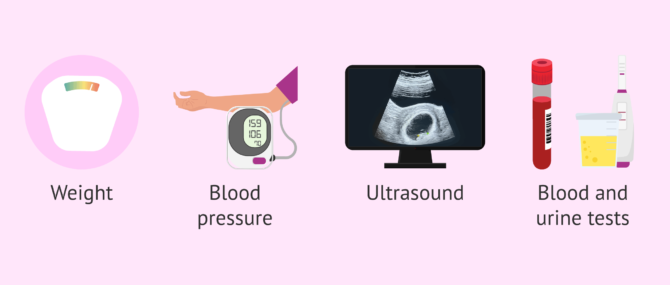The second month of pregnancy covers weeks five to eight, which means that it lasts 8 weeks in total.
This month starts with a missed period that leads the woman to consider the possibility of being pregnant, which can be confirmed with a pregnancy test.
The symptoms to expect at this stage are more intense than in the first month. However, your stomach will not get bigger yet. As one shall see below, the most noticeable changes occur in the embryo.
Provided below is an index with the 8 points we are going to expand on in this article.
- 1.
- 1.1.
- 1.2.
- 1.3.
- 1.4.
- 2.
- 2.1.
- 3.
- 4.
- 4.1.
- 4.2.
- 4.3.
- 5.
- 5.1.
- 5.2.
- 5.3.
- 5.4.
- 5.5.
- 5.6.
- 5.7.
- 5.8.
- 6.
- 7.
- 8.
What happens at 2 months of pregnancy?
After the first month of pregnancy, the embryo is already attached to the uterus of the mother. This causes a series of symptoms on her, including nausea and missed period.
From this moment on, embryo development occurs so fast that the first embryonic structures will be visible through ultrasound scan very soon.
In the following sections, you can find detailed explanations on the most notorious changes that occur in the embryo by week:
Week 5
The fifth week of pregnancy coincides with the third week of embryo development. In other words, fertilization took place three weeks ago.
Gastrulation occurs during this week. This process entails the development of the three layers from which all the embryo’s tissues will develop.
The head also grows but its size is still out of proportion since it is larger than the trunk. The body is rather a sort of tail.
The following are the embryo's three germ layers explained:
- Ectoderm
- This outer-most germ layer originates from the epiblast. It is the origin of several tissues and organs, like the nervous system and skin.
- Mesoderm
- This intermediate germ layer forms from the epiblast. It develops into muscles, bones, reproductive and circulatory systems...
- Endoderm
- The inner germ layer of the embryo, which originates from the hypoblast and some cells that migrate from the epiblast. It develops into the digestive tract, respiratory system, liver, and most internal organs.
You may also enjoy some further information reading this: What Is the Purpose of Gastrulation in Embryonic Development?
The notochord starts developing from the mesoderm. The notochord is a flexible rod-shaped body whose main function is to serve as a support structure until the backbone or vertebral column is formed.
The embryo measures between 1 to 2 mm, and the head starts being distinguishable at one limb. However, it is not visible using an ultrasound scan yet.
A primordial heart is developing with a single chamber. It is not functional and cannot be heard with a fetal Doppler, though.
You may like: The Fifth Week of Pregnancy.
Week 6
When the sixth week starts, the embryo can measure up to 2-4 mm, and its size continues increasing quickly. Primordial organs are developing progressively, a process that continues until the end of pregnancy.
A major change that occurs on week 6 is that the primordial heart starts beating spontaneously. The fetal heart rate is faster than that of an adult—about 150 beats per minute (bpm).
On the other hand, the optical vesicles start their development on both sides of the bead, which are the precursor cells that will develop into the eyes. In the middle part of the embryo, the intestine starts to be noticeable, which is the origin of the digestive system.
Further reading: The Sixth Week of Pregnancy.
Week 7
The embryo has doubled his size at this point, as it is now about 1 cm long from the head to the tail.
The formation of all organs progresses very fast: the neurons develop, and so does the liver, pancreas, intestines, bronchi, respiratory system, digestive tract...
The umbilical cord develops at this stage. From this moment on, it will supply the fetus with food. Apart from providing the fetus with multiple nutrients, it will supply the baby-to-be with the necessary blood so that embryo development occurs in the right way.
If you found this interesting, why don't check out the following post? The Seventh Week of Pregnancy.
Week 8
By the end of this week, the fetus already measures between 1.3 to 1.8 cm in length.
Skin formation starts during this week, although organs are visible underneath this thin layer of wrinkled, translucent skin. The heart, which started to develop at the beginning of this month, has now four chambers. It is now capable of pumping blood and beats at 180 bpm, which is twice the frequency of an adult’s heart.
Read this next: The Eighth Week of Pregnancy.
Fetal development
As mentioned in previous sections, substantial embryonic changes occur during the second month of pregnancy. Organogenesis starts at this stage, and in just four weeks, most organs and primordial systems appear. Their development continues during the entire course of pregnancy, though.
On the other hand, the placenta and umbilical cord form throughout this month, and become fully functional by the end of week 8. From this moment on, the placenta is in charge of providing the embryo with all necessary nutrients via maternal blood, as well as removing waste material.
During the first two months of pregnancy, nourishment of embryo was dependent on the vitelline duct, an embryonic extension that disappears at this stage.
After the second month of pregnancy, the fetus can measure up to 2 cm and weight 3 grams approximately. Due to its small size and the early stage of development, it is still too early for the mother to feel the baby-to-be. However, he can make imperceptible moves now.
First ultrasound scan
Broadly speaking, performing an ultrasound scan before the eighth week of pregnancy is unadvisable. The rational for this is that it is possible that the embryo cannot be seen yet because it is too early. This causes great stress on the woman as she may think that something is wrong.
According to experts, ideally the first ultrasound scan should be performed on week 8 or later. At this point, it allows us to measure the embryo for the first time in order to monitor fetal development. Confirming the heartbeat helps to confirm that it is an ongoing pregnancy.
When pregnancy has been achieved via Assisted Reproduction, the first ultrasound scan is typically performed earlier than in natural pregnancies, usually on week 7 of pregnancy after a positive beta-hCG test. The goal of this action is to see the number of gestational sacs to determine whether it is a multiple pregnancy, and if everything is going as it should.
Symptoms & changes in the woman
Sudden changes of mood, oversensitivity, and irritability are very common among pregnant women due to the drastic impact of hormonal changes as well as every process that is developing within you.
Moreover, such hormone adjustments may cause you to feel nausea and sickness due to increased levels of beta-hCG from week 5 onwards.
You are likely to notice a slight increase weight gain, along with a series of discomforts that occur from the uterus expanding, including abdominal and leg cramps, heartburn, sciatic nerve pain, strong urge to pee, constipation, etc. Also, an increase in maternal plasma volume occurs in order to nourish the unborn baby.
It is still too early to notice these body changes at a glance. Usually, your stomach starts to get bigger from the third month of pregnancy and continues to do so up until childbirth.
On the other hand, the cervix usually becomes softer. This is the reason why having a mild spotting after intercourse is normal.
Exhaustion is another symptom that you may notice from the second month of pregnancy onwards. During the first trimester of pregnancy many women feel a continuous need for sleep as well as exhausted and drained all the time.
Pregnancy also affects the sense of taste (dysgeusia). Therefore it is likely that your meal preferences change and you have an increased or decreased appetite.
Moreover, you may experience an increase in breast growth, something that may be painful. You may begin to notice small nodules or pimples around your areola known as Montgomery tubercles.
Read more: What Are the Most Common Symptoms of Pregnancy?
Care and tips
When a woman finds out that she is expecting, she should start establishing healthier habits, taking special care of her body and its adaptation to the new situation.
By doing this, you can relieve most of the annoying symptoms we have mentioned above, in addition to favor a healthy fetal development.
The following sections will provide you with a series of recommendations on maternal and fetal health to follow during the 2nd month of pregnancy:
Food
Soon as your doctor starts monitoring your pregnancy, he or she will recommend that you take certain food supplements containing folic acid, an essential vitamin to prevent fetal malformations.
It is also crucial to eat a balanced diet that includes the following essential nutrients: iron, calcium, iodine, zinc, vitamin D, fiber, and omega-3 fatty acids.
Likewise, there are certain foods that one should avoid while pregnant, since they can be harmful for you and the fetus. Raw meat and fish, seafood, sausages, milk, unpasteurized cheese, etc. are some examples. All of them may cause toxoplasmosis or listeriosis.
Coffee and alcoholic drinks are totally unadvisable during pregnancy, as they can increase the risk of fetal death.
In addition to all this, your personal hygiene matters in pregnancy as well, especially when preparing meals: washing your hands, keeping food preparation areas and equipment clean, rinsing raw fruits and vegetables thoroughly before eating, etc. is crucial.
Certain eating habits can help reduce nausea and other pregnancy symptoms, including:
- It is best to eat 5–6 small meals per day
- Snack between your regular meals if you need to
- Eat protein-rich foods, such as food, fish, and eggs
- Drink ginger tea
Last but not least, although drinking plenty of water is vital, overhydration might be counterproductive if you have severe nausea.
Exercise
Do not stop exercising during pregnancy unless it is unsafe for you, the baby, or both. In any case, you should adapt the exercises to each stage of pregnancy.
In particular, during the second month of pregnancy, women who played sports on a regular basis can continue with their normal routine, although we recommend that they reduce intensity to prevent trauma.
Physical activity that requires excessive abdominal work or contact and collision sports are not recommended, though.
The safest sports during pregnancy are pilates, yoga, swimming, cycling, or walking for 40 minutes a day every two days.
If you are not used to playing any sport, you should consider taking one up. Moderate exercise as many benefits for pregnant women: it reduces back pain, helps sleep better, and makes postpartum recovery faster. Moreover, resistance training may improve endurance in preparation for labour.
Check out this for more information: Physical Activity and Exercise During Pregnancy.
Follow-up examinations
Commonly, the initial medical visit takes place at the end of this month once pregnancy has been confirmed.
During the first prenatal visit, your doctor will check your body to monitor your weight and blood pressure. The first ultrasound scan, as indicated above, is usually performed on weeks 8-12 in order to be able to see the embryo.
Your doctor will examine your breasts and ask you for a blood and urine test, too. The rationale for this is to look for the presence of antibodies of viruses like hepatitis, toxoplasmosis, and rubeola.
Actually, the second month is a very early stage of pregnancy, and for this reason you should pay attention to any alarming sign, suck as bleeding or intense pains. Any abnormal symptom may indicate that you are at risk of miscarriage or ectopic pregnancy.
FAQs from users
What can spotting in the second month of pregnancy indicate?
Spotting is very common in the first trimester of pregnancy. Any spotting in the first trimester is considered a threat of miscarriage.
Spotting can be due to different causes. The most important thing to do is to see your gynecologist to find out the origin of the spotting. Possible causes include hematoma, low insertion placenta, polyp in the cervix, etc.
What is 2 months pregnant in weeks?
The second months of pregnancy covers from week 5 to week 8 of pregnancy. In other words, being two months pregnant equals being 8 weeks pregnant.
Can you feel the baby move at two months?
From weeks 7-8 of pregnancy, the baby can move inside the uterus, but it is not until weeks 16-22 when the woman will notice his movements. So, at two months, the woman just has notices the first symptoms of pregnancy. If you feel that your baby is moving, it is likely to be caused by flatulence, a symptom that is commonly confused, specially in first-time moms.
What does a two months pregnant belly look like?
Actually, the belly is not visible yet. The embryo is still too little to cause the stomach to grow. So, unfortunately, the belly is still not visible to the naked eye.
Is it normal to be 2 months pregnant and not feel anything?
The first pregnancy symptoms typically starts in the second month. Each woman is different, and so are the symptoms she may feel when pregnant. In conclusion, not feeling anything during the second month is not an alarming issue. In other words, it does not mean that anything goes wrong.
Can you sleep on your stomach when pregnant second month?
Yes, you can sleep in whatever way is more comfortable for you. Moreover, during the first months of pregnancy, your stomach has not grown bigger yet.
Nonetheless, as the pregnancy progresses, the most recommendable is to sleep on your side.
What are the most common symptoms in the second month of pregnancy?
The most common symptoms in the second month of pregnancy are morning sickness and the absence of menstruation. In addition, some women experience cravings for certain foods and rejection of others, dizziness, fatigue, heartburn and mood swings. These mood swings are normal, as they are due to the high hormonal load of pregnancy.
Is sexual intercourse possible in the second month of pregnancy?
Pregnancy is not a situation that prevents sexual intercourse, nor will it pose a danger to the baby. The important thing is to find a position in which the pregnant woman is comfortable.
Suggested for you
After week 8 of pregnancy, the third month of pregnancy starts, and the embryo is now considered a fetus. Want to learn the difference between embryo and fetus? Read: What’s the Difference between Zygote, Embryo & Fetus?
To get more info on the foods to eat during pregnancy and how to take care of yourself, we recommend that you visit this guide: How to Take Care of You & the Baby While Pregnant.
We make a great effort to provide you with the highest quality information.
🙏 Please share this article if you liked it. 💜💜 You help us continue!
References
Alcolea Flores, S., Mohamed Mohamed D. Guía de cuidados en el embarazo. Consejos de su matrona. Hospital Universitario de Ceuta (Dirección Territorial de Ceuta e Instituto Nacional de Gestión Sanitaria (ed.). Colección Editorial de Publicaciones del INGESA. ISBN: 978-84-351-0408-1
Cunningham F, MacDonald P, Gant N et al. (1996). Adaptación maternal al embarazo. Masson SA. Cunningham F, MacDonald P, Gant N, et al. 4ª ed, Barcelona; pp. 201-237
Eisenber, A. (1991) What to Expect When You’re Expecting, New York, NY: Workman Publishing Company, Inc.
Grupos de trabajo de la Guía de Embarazo y Parto, Guía de Salud Oral, y Guía de Lactancia Materna. Consejería de Sanidad, Dirección General de Salud Pública y Servicio de Salud del Principado de Asturias. Octubre de 2015.
March of Dimes, Pregnancy & Newborn Health Education Center. Exercise during Pregnancy. Retrieved March 11, 2008
Miller DL. Safety assurance in obstetrical ultrasound. Semin Ultrasound CT MR 2008;29:156–64
National Health Service (NHS) (UK) (2009). The Pregnancy Book. Your complete guide to: A healthy pregnancy, Labour and childbirth, The first weeks with your new baby. Crown copyright 2009. Produced by COI for the Department of Health.
Obstetricia 4ª edición. J. González Merlo. Ed. Masson. Barcelona, 2003
Ramírez García O, Martín Martínez A, García Hernández JA. (2003). Duración del embarazo. Modificaciones de los órganos genitales y de las mamas. Molestias comunes del embarazo normal. Panamericana Ed. Tratado de Ginecología, Obstetricia y Medicina de la Reproducción. Cabero Roura L, Madrid.
Salvesen KÅ, Lees C, Abramowicz J, Brezinka C, Ter Haar G, Maršál K. Safe use of Doppler ultrasound during the 11 to 13 + 6-week scan: is it possible? Ultrasound Obstet Gynecol 2011;37:625–8
Sheiner E, Shoham-Vardi I, Abramowicz JS. What do clinical users know regarding safety of ultrasound during pregnancy? J Ultrasound Med 2007;26:319–25.
The American College of Obstetricians and Gynecologists. (2005). Your Pregnancy and Birth (4th ed.). Washington, DC: Meredith Books.
The American Dietetic Association. (2008) Position of the American Dietetic Association: Nutrition and Lifestyle for a Healthy Pregnancy Outcome. Journal of the American Dietetic Association. 108:553-561.
FAQs from users: 'What can spotting in the second month of pregnancy indicate?', 'What is 2 months pregnant in weeks?', 'Can you feel the baby move at two months?', 'What does a two months pregnant belly look like?', 'Is it normal to be 2 months pregnant and not feel anything?', 'Can you sleep on your stomach when pregnant second month?', 'What are the most common symptoms in the second month of pregnancy?' and 'Is sexual intercourse possible in the second month of pregnancy?'.
